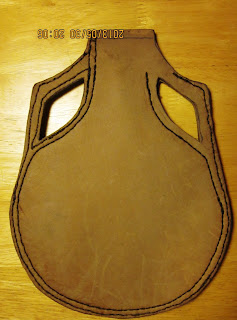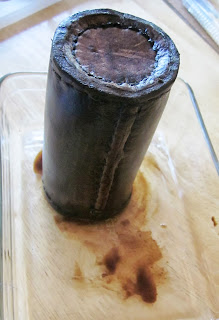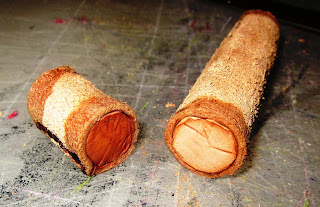Yet another project that stemmed from my need to create a full and complete kit for a medieval friar. I expect to be walking around all day, every day in wool robes on days in direct sun when it has a great chance of being over 90 degrees each day.... What will I need? Water!
I did a little digging around to see what sort of devices one might use to carry water and I found two options.
1) Leather Canteen.
2) Leather Costrel.
After discussing the matter with one of my judges at the recent A&S competition he directed me towards the easier of the two options... the canteen. He indicated that even with his many many years of experience he had issues creating a costrel which didn't leak. I understand the concept and the approach but I am constrained by time and don't want to risk spending weeks on a project only to find that it leaks. I decided that I would make a leather canteen with no embellishments.
I understand that there are two theories for creating a canteen.
Option 1: Stitch two pieces of leather together and jam them full of sand or some other medium while the leather is wet.
Option 2: Create a form which to stretch the leather over and then stitch the two pieces together.
Both have their arguments, pros and cons. I opted for the easier of the two. Actually I wanted to cut and sew leather and didn't have an interest in carving a form at this point. I will, some day create a version using the forms and even a 3 part costrel, but not this year and not for Pennsic.
After sketching out a roundish option, I cut the 7/8 ounce vegetable tanned leather and began marking it for stitching.

Not much in the way of interesting things happening here. Just a few hours of sewing. I was able to get all of this cutting and sewing done in one day. Well, one long evening. This page probably represents about five hours of work or so. Based on that rate I imagine I'll be looking at about 10 or so hours total sewing time for the entire canteen.
When I finished for the night I put the leather work in progress project in a bucket of water. I plan on extracting it the tonight or tomorrow to finish up the sewing.
I night soaking in the bucket...I was a bit worried that the leather had been in the bucket of water for a long time, but stitched up just fine.
Finished the sewing and getting ready to stuff. Color looks a bit different, but that is the camera. I had to switch cameras as my kids took the other one on a trip.
I found these cool copper funnels at Salvation Army a while back. I was never really sure what I would do with them, but when I see cheap copper items, I snatch them up. I planned on cutting it up and reusing the metal, but it turns out that I'm glad I didn't. The smaller version worked great for this project.
The smaller funnel fit perfectly in the top of the canteen. I purchased some "washed play sand" from Home Depot. After placing the funnel in the opening I simply jammed it into the canteen a little at a time.

At this point I was wondering how full I could get it. I kept using the wooden spoon to jam as much sand in as I could. My hand started hurting from pressing the spoon over and over. When it felt like I was packing it onto concrete I figured I was done. Now I just have to wait a week for it to dry out. I hope I didn't pack it too hard that the sand won't come back out. We shall see. So far it looks pretty cool though.


























































